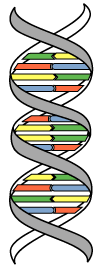|
Rotten Library > Medicine > DNA
DNAaka deoxyribonucleic acid How did life first get started on this planet? And why does it suck so much? The answer is found in DNA.
How did life first get started on this planet? And why does it suck so much? The answer is found in DNA. DNA was discovered in 1869, but at the time, no one really knew what it was or whether it was important. Scientists knew that it was a complicated molecule found inside the cells of living things, and they suspected it had something to do with heredity. In 1944, quantum physicist Erwin Schrodinger (of "Schrodinger's Cat" fame) published a collection of lectures titled What is Life? Schrodinger postulated that all life was somehow designed according a pre-set script that could found among the molecules of the body. Following on his discoveries in the study of subatomic systems, Schrodinger believed that information about the structure of a life form was physically encoded into the life form at a very small scale, and that the code was inherited by each generation from the previous. Schrodinger challenged his contemporaries in the life sciences to find that code. In the 1950s, two young scientists named James Watson and Francis Crick discovered that the molecules of DNA were coiled up in the double helix formation. A couple of years later, an experiment using bacteria proved that DNA was the medium for transferring hereditary -- also called genetic -- information.
The DNA molecule is twined very tightly, so that a large number of atoms fit into a very small space. Each strand of DNA contains a number of smaller molecule-like clusters of atoms, known as nucleotides. There are four nucleotides, each usually represented by a letter -- A, T, C, or G. From here out, everything you read is going to be pretty grossly oversimplified. The nucleotide letters are arranged into three-letter "words" known as codons. There are 64 codons, or 64 possible combinations of the four nucleotides. (There are also 64 hexagrams in the I-Ching, which may or may not be a coincidence.) Each codon is sort of like a command in computer coding -- an instruction on how to do something. Each set of instructions is framed by a "start" and "stop" codon. These markers are like a set of parentheses. Inside the parentheses, there is one specific set of instructions, which is almost always (Make a protein.) When a new set of parentheses begin, a new instruction has been launched, such as (Make a different protein.)
The RNA then drops into a simmering stew of amino acids, which are the carbon-based raw materials of life. The amino acids interact chemically with the RNA segment to make proteins, in a type dictated by the information copied from the parenthetical DNA segment. Like the gears and springs in a pocket watch, proteins are the fundamental machines that do the work of life within a cell. If your eyes are glazing over right about now, don't feel bad. It's insanely complicated. Here's an absurdly oversimplified (but surprisingly reasonable) way to think about it: DNA is like a long string of connected Legos®, and RNA is like Play-Doh®. The Play-Doh (RNA) presses onto the string of Legos (DNA), which leaves an indentation in the Play-Doh. The Play-Doh gets tacky and falls away from the Legos. The now-stiff Play-Doh drops into a pile of loose Legos (amino acids). As they bang around together, appropriately shaped Legos snap into the impressions left in the Play-Doh to make a new Lego construct (a protein). The type and number of proteins in a cell determine whether the cell is a bone cell, a blood cell, a brain cell, or a spleen cell. By following some specific combination of codons in a segment of DNA, RNA manufactures all the parts that go into a cell, and by following the entire recipe book (decoding the entire strand of DNA in the correct order and with the proper raw materials), you can incubate an entire person... or cat, dog, mouse, aardvark, bacterium, virus, fungus, sunflower or dragonfly. So this bizarre little super-complicated molecule holds basic recipe book on how to build a human being in about eleventy million trillion easy steps. How did this come to be?
Experiments have demonstrated that the combination of base chemicals and environmental conditions on primitive Earth -- including lava, electrical storms, carbon and water -- were conducive to the formation of complex organic molecules. Some organic molecules formed on Earth; others may have been dropped here by passing comets or meteors. It's not quite clear how, but all these factors appear to have come together to form RNA first, then RNA eventually became more complex and developed into DNA. There isn't really any one view about how this happened, but the earliest forms of life derived from these first building blocks. Well, according to most views, anyway. From these simple building blocks, more complex forms of life evolved through the process of mutation. Because the process described above are extremely complex and involve millions of small chemical changes, there are numerous opportunities for something to go wrong between the Legos and the Play-Doh.
Although the stuff was unimaginable just 200 years ago, DNA is now a part of everyday life. Because each person inherits a unique genetic sequence, DNA has revolutionized criminal investigations by offering a not-quite infallible method of identifying suspects from the blood, semen, spit and hair they leave behind. DNA testing can be used to establish paternity within an inconsequential margin of error. In medicine, DNA grows more prominent every day. Although the genetic code still contains mysteries, scientists have managed to unlock genetic markers for various diseases. Some diseases are directly caused by faulty DNA. Gene therapy -- in which healthy DNA is spliced onto damaged DNA -- is still in its early stages. Gene therapy shows promise in principle, but its track record in clinical trials to date isn't stellar. Then there's genetic engineering. We may not fully understand how DNA works, or where it came from, or exactly precisely how all those little codons work, but in typical human form, we have already figured out how to monkey with them. Genetic engineering is rampant in the U.S. food industry, including tomatoes, beets, wheat and corn. On the bright side, GE has made foods more resistant to spoilage, more easily processed, or more easily cooked. GE hybrids, whether plants or animals, are known as transgenic organisms.
Much of this gene splicing is done by introducing an engineered virus into the host organism. By their nature, viruses tinker with the DNA of host cells, so the strategy has a certain logic behind it. On the other hand, if you think there's something inherently alarming about creating viruses and introducing them into animals in order to create bizarre new interspecies hybrids, you're not alone. The ultimate frontier -- tampering with the DNA of human beings -- is just around the corner. Rumors of human cloning persist, but no proven clones have surfaced yet. There are two predominant reasons to tamper with human DNA -- to improve the health of a living human, or to breed children with specific traits, presumably superior ones. Experiments in the former area have been hampered because patients have an annoying tendency to die. It turns out that inserting genetically engineered viruses into people and animals can be bad for their health. Who would have thought it? Experiments in the latter field, sometimes known as eugenics, are equally troublesome. Although trials with animals have produced super-smart mice and sheep whose breast milk contains insulin, it's still relatively taboo to talk about manufacturing smart, beautiful children with an insatiable appetite for world domination.
Although current efforts are mostly limited to examining ways to diagnose and treat genetically transmitted diseases like cystic fibrosis and cancer, you know it won't be long before we're all battling for our lives against a generation of supermen whose genes for morality were accidentally excised by an overeager scientist trying to prevent warts. Naturally, we won't be able to beat them. You can only hope that the technology to create these superbabies won't exist during our lifetimes... which would be fairly pointless since the technology pretty much exists already, held in check by only a rapidly fraying string of ethical posturing. After all, the last time you stopped at McDonald's, you ate a tomato with fish genes in it. Pretty much anything goes after that. O brave new world!
|
 By the time you finish reading this next section, you might well think DNA stands for "Do Not Ask," but it's actually an abbreviation for deoxyribonucleic acid. DNA is a string-shaped molecule arranged as two strands spiraling around each other, connected through the middle by hydrogen atoms. The shape is known as a "double helix."
By the time you finish reading this next section, you might well think DNA stands for "Do Not Ask," but it's actually an abbreviation for deoxyribonucleic acid. DNA is a string-shaped molecule arranged as two strands spiraling around each other, connected through the middle by hydrogen atoms. The shape is known as a "double helix."  We know that the origins of DNA are the origins of life on this planet. Unfortunately knowing that and knowing the actual origins of DNA are two different things.
We know that the origins of DNA are the origins of life on this planet. Unfortunately knowing that and knowing the actual origins of DNA are two different things.  Although DNA can repair itself to a certain extent, some errors persist and are inherited by the next generation of the life form in question. Over the course of a great deal of time, this eventually led to the development of opposable thumbs, tonsils and third nipples.
Although DNA can repair itself to a certain extent, some errors persist and are inherited by the next generation of the life form in question. Over the course of a great deal of time, this eventually led to the development of opposable thumbs, tonsils and third nipples.  In order to accomplish this goal, genetic engineers do some questionable things, like splicing fish genes onto strawberries to keep them from freezing, or splicing human genes into chickens to make them grow larger more rapidly. Some early experimentation has been done splicing human DNA into pigs in order to grow pigs with organs that can then be transplanted into humans. (Would eating bacon from these pigs constitute
In order to accomplish this goal, genetic engineers do some questionable things, like splicing fish genes onto strawberries to keep them from freezing, or splicing human genes into chickens to make them grow larger more rapidly. Some early experimentation has been done splicing human DNA into pigs in order to grow pigs with organs that can then be transplanted into humans. (Would eating bacon from these pigs constitute  In the old days, eugenics had to be accomplished through the cumbersome task of selective breeding, but modern geneticists are increasingly able to manipulate DNA directly to enhance qualities such as strength, resistance to disease and intelligence. Although
In the old days, eugenics had to be accomplished through the cumbersome task of selective breeding, but modern geneticists are increasingly able to manipulate DNA directly to enhance qualities such as strength, resistance to disease and intelligence. Although